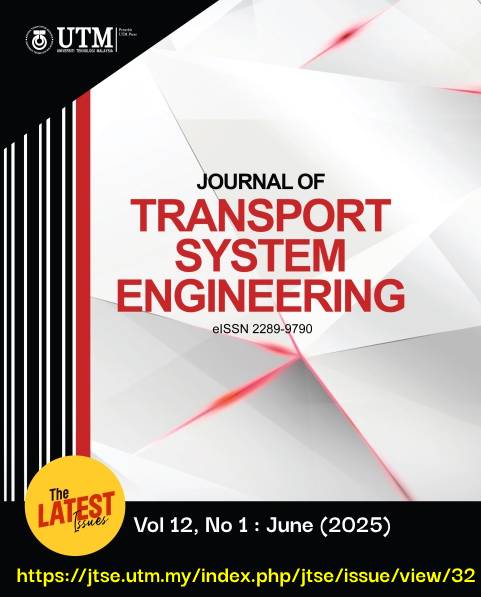Influence of Organic Friction Modifiers on Surface Energy Properties in Polyalphaolefin (PAO) Blends
DOI:
https://doi.org/10.11113/jtse.v12.242Keywords:
Polyalphaolefins, Stearic Acid, Oleic Acid, Contact Angle, Friction, Wear.Abstract
The shift towards alternative fuels like hydrogen, ethanol, and other sustainable energy sources drives the need for high-performance lubricants to handle new thermal and chemical challenges. Synthetic polyalphaolefins (PAOs) are commonly utilised due to their thermal stability, high viscosity index, and reliable low-temperature flow. This study investigates the impact of organic friction modifiers—oleic acid (OA) and stearic acid (SA)—on PAO-based lubricants' tribological and interfacial characteristics. Blends containing 0.1–0.5 wt% OA or SA were tested. Contact angle measurements indicated that the 0.3 wt% OA blend significantly improved surface wettability, achieving the lowest contact angles on glass and steel surfaces. Surface energy analysis revealed decreased surface tension and better adhesion for the 0.3 wt% OA blend. Friction testing showed that the 0.3 wt% OA blend recorded the lowest coefficient of friction; however, wear resistance largely remained unaffected. These findings indicate that OA improves frictional performance in PAO lubricants, presenting a promising avenue for optimising formulations for future energy systems.
References
Spikes, H. (2015). Friction modifier additives. Tribology Letters, 60(1), 1–26. https://doi.org/10.1007/s11249-015-0589-6
Al-Quraan, R., et al. (2023). A methodological approach to assessing the tribological properties of lubricants using a four-ball tribometer. Tribology International, 181, 108118. https://doi.org/10.1016/j.triboint.2023.108118
Tomala, A., et al. (2015). Interaction between selected MoS₂ nanoparticles and ZDDP tribofilms. Tribology International, 90, 454–461. https://doi.org/10.1016/j.triboint.2015.05.033
Kalin, M., Polajnar, M., & Vižintin, J. (2013). The correlation between the surface energy, the contact angle, and the spreading parameter, and their relevance for the wetting behaviour of DLC with lubricating oils. Tribology International, 66, 225–233. https://doi.org/10.1016/j.triboint.2013.05.012
Meylan, B., et al. (2017). A new ball-on-disk vacuum tribometer with in situ measurement of the wear track by digital holographic microscopy. Surface Topography: Metrology and Properties, 5(4), 045007. https://doi.org/10.1088/2051-672X/aa9537
Gulzar, M., et al. (2016). Tribological performance of nanoparticles as lubricating oil additives. Journal of Nanoparticle Research, 18, 223. https://doi.org/10.1007/s11051-016-3524-5
Li, Y., et al. (2019). Friction reduction and viscosity modification of cellulose nanocrystals as biolubricant additives in polyalphaolefin oil. Carbohydrate Polymers, 203, 1–10. https://doi.org/10.1016/j.carbpol.2018.08.053
Kozbial, A., et al. (2014). Study on the surface energy of graphene by contact angle measurements. Langmuir, 30(23), 8598–8606. https://doi.org/10.1021/la501998t
Song, Y., et al. (2019, March 14). Interaction of surface energy components between solid and liquid on wettability, and its application to textile anti-wetting finish. Colloids and Surfaces A: Physicochemical and Engineering Aspects, 570, 424–431. https://doi.org/10.1016/j.colsurfa.2019.03.014
Dolatabadi, N., Rahmani, R., Rahnejat, H., Garner, C. P., & Brunton, C. (2020, February 7). Performance of poly alpha olefin nanolubricant. Tribology International, 144, 106095. https://doi.org/10.1016/j.triboint.2019.106095
Coelho de Sousa Marques, M. A., et al. (2021). Heat capacity, density, surface tension, and contact angle for polyalphaolefins and ester lubricants. Journal of Chemical & Engineering Data, 66(5), 2203–2212. https://doi.org/10.1021/acs.jced.0c00871
Ratoi, M., et al. (2013, December 3). The impact of organic friction modifiers on engine oil tribofilms. RSC Advances, 3(46), 24786–24794. https://doi.org/10.1039/C3RA44785E
Lee, M. B., Lee, C. T., Chong, W. W. F., & Wong, K. J. (2023). Post-thermal annealed monolayer graphene healing elucidated by Raman spectroscopy. Journal of Materials Science, 58(25), 10288–10302.
Kwok, D. Y., & Neumann, A. W. (1999). Contact angle measurement and contact angle interpretation. Advances in Colloid and Interface Science, 81(3), 167–249. https://doi.org/10.1016/S0001-8686(98)00087-6
Redzuan, N. Q., Halid, I., & Hamdan, S. H. (2023). Analysing the lubricant rheology-pressure relation for biodiesel derived waste palm cooking oil (WPCO). Journal of Transport System Engineering, 6(2), 1–7.
Lee, M. B., Balan, E. A., & Lee, C. T. (2023). Enhancing trimethylolpropane trioleate biolubricant with methyl laurate additive. Journal of Transport System Engineering, 6(2), 8–1.
Downloads
Published
How to Cite
Issue
Section
License
Copyright of articles that appear in Journal of Transpot System Engineering (JTSE) belongs exclusively to Penerbit Universiti Teknologi Malaysia (Penerbit UTM Press). This copyright covers the rights to reproduce the article, including reprints, electronic reproductions or any other reproductions of similar nature.
Disclaimer: The views and opinions expressed in the articles are those of the authors and do not necessarily reflect the official policy or position of the JTSE. Examples of analysis performed within are only examples and they should not be utilized in real-world. Assumptions made within the analysis are not reflective of the position of any JTSE entities.


















